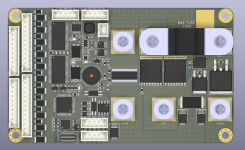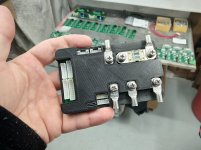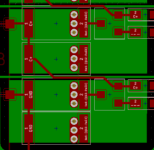Solarsail said:
"Does not generate heat" is not the same as 0%.
Yes, it is. You can generate a small amount of heat, of course. A straight wire from the input charge terminals to the cells would generate a small amount of heat. A DC/DC converter would generate a lot more.
Tell me, how much will the temperature of a 20 kg metal box of volume 12 liters rise due to a 5A switching mosfet, where the 60V DC supplied power is rectified, DC-DC converted and conditioned OUTSIDE the box? Numbers please.
Impossible to answer. To answer I'd need the thermal impedance from junction to ambient. If it was perfectly insulated, then the temperature would keep rising indefinitely until you exceeded the 175C limit of the FET and then it would fail.
Have you built such a circuit? I have.
Yes. It's my job.
Take any standard cheap 24V switching power supply. It does not allow for current regulation and current limitation except for short and exceptional conditions. It consists of AC to DC rectification and filtration, then a switching DC to DC step-down converter/isolater both of which generate heat. There is no CCCV function.
Many people here use Meanwell power supplies - cheap Chinese power supplies that convert AC to DC. They have a CCCV function. The CV function is robust and tightly regulated, since most power sinks require tightly regulated voltages. The CC function is less well regulated since ordinarily it is merely circuit protection. But it works well enough for ebike batteries, since most people are not trying to push the charge limits as hard as they can. Batteries don't care much if you charge them at .4C instead of .35C.
The supplied voltage will stay approximately constant 24V and the current will vary according to ohm's law (unless the rating is exceeded). So it has a CV function but not a CC function or the ability to drop the voltage.
Every modern supply you get will have a current regulation function. It will be one of two types - current limiting (the type you want for a charger) or hiccup (shutdown and retry.) This, again, is because they have to do this for circuit protection and reliability. The only challenge for someone attempting to use one as a charger is to ensure that it's the current limiting type. Meanwell spells this out in their data sheet, which is one reason they are popular for ebike chargers.
In addition, the CV function lacks tolerance and may not be suitable for a li-ion pack in CV mode even if your cells add up exactly to 24V at 100% SoC.
The Meanwell supplies I have used are good to within 1% when trimmed, and will hold that regulation even when they heat up.
A switching mode DC to DC step-down regulator with a low Rds at 5A and associated circuitry generates negligible heat. A IRFZ44 at 100% duty cycle will generate .0175 * 25 = 0.43 W of thermal energy.
If it's at 100% duty cycle you don't need the FET. Just use a wire. That's a LOT cheaper and more efficient.
How much switching energy will you lose at 99% duty cycle? That's the loss required to pump the gate capacitance up and down, as well as charge and discharge the D-S capacitance and any snubber capacitance across the switchnode.
How about core losses in the inductor? Depends on core material. Maybe you find a good inductor with Fair-Rite type 76 material. Nice and small but gets a little warm. No problem - go to type 73 material, which has 30% less loss. Uh oh - permeability just went down. Now you need more turns for the same inductance. And all the turns you need don't fit, so you have to go up one size. Now ohmic losses are starting to increase (more wire) so you have to go to a heavier gauge. But with the heavier gauge skin effect becomes more of an issue. Do you do a bifilar wind? Maybe but now you need twice as much thinner wire, and now it doesn't fit . . .
That's the reality when you start with the idea "I'll just make this simple super efficient DC/DC."
Real world DC/DC's run at about 95-96% efficiency if you do a good job in design, and if you keep control of their use cases (i.e. input voltage close to output voltage, max load.) So let's look at your 60V 5A DC/DC. That's 300 watts. A 95% efficient DC/DC will generate about 15 watts of heat. Not a lot - but enough to significantly warm one side of the pack.
If that's OK for you, and you're willing to accept the tendency for that to unbalance the pack, then go for it. But there's no reason to take a simple design and complicate it by adding another switchmode converter.
The rest of the circuit even less. Please let me know when you have calculated the temperature rise.
Sure, as soon as you tell me theta JA.
Cheap off the shelf power supplies are not suitable for charging li-ion packs without a CCCV function. In fact they are unable to drop the voltage.
At this point I'd suggest you get some real world experience with lithium ion charging.
How do you suggest simultaneously charging 18 modules each 14s11p, with the modules hard wired as 3p6s, and with no internal contactors, with just one charger?
I'd get a 60V supply that did current limiting for overload protection, trim it to 58.8V and use that.
Maybe you know how Tesla does this, and I am all ears. I would like to avoid timesharing the single charger and multiplexing the power.
Tesla uses ~400VDC battery packs. When DC charging they use an external 400VDC charger. They also have very extensive battery monitoring and balancing systems inside the pack.




